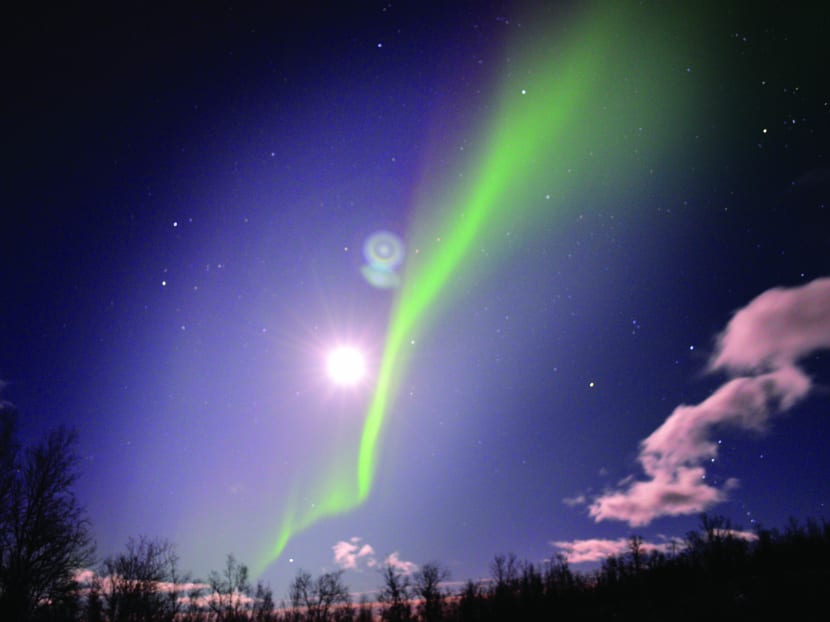Japanese start-up to light up sky with on-demand shooting stars
TOKYO — To catch a falling star, luck might not be a factor any more.

A shooting star and aurora borealis seen across the sky. TODAY file photo
TOKYO — To catch a falling star, luck might not be a factor any more.
Dr Lena Okajima, an entrepreneur in Japan, wants to get into the business of delivering tiny artificial meteors sent up in rockets, released from a satellite on command and bright enough to illuminate the night over light-flooded cities.
Dr Okajima’s wish-upon-a-star moment happened 15 years ago in a cow pasture outside Tokyo, when the former researcher went to see the Leonids, meteor showers seen every November as the earth orbits through a trail of debris left by a comet.
“Pretty much everyone has thought about the possibility of creating artificial shooting stars before, but no one has thought about monetising it as a business,” said Dr Okajima, 37, who has a Ph.D. in astronomy from the University of Tokyo. Instead of going into research, the stargazer worked on games for mobile phones, lost a job at Goldman Sachs and worked part-time jobs before launching her endeavour.
Ale Co, which Dr Okajima runs with five people out of a small office in Tokyo, could start offering on-demand meteor showers by 2018, using a carry-on-sized satellite packed with as many as 1,000 centimetre-sized pellets. Released remotely from earth and available in different colours, the shooting stars would be seen by as many as 30 million at a time in urban areas — they may even be ready in time for the 2020 Tokyo Olympics.
Event organisers, governments and theme-park operators are Ale’s most likely customers, similar to how fireworks shows are already put on. Wealthy individuals may also be potential buyers, Dr Okajima said. Japan is also an ideal place to launch this kind of business, given the popularity of the spectacles here. The archipelago’s fireworks industry was worth ¥5.2 billion (S$65.6 million) in 2014, according to the Japan Pyrotechnics Association.
“In the sense that you light up the sky, shooting stars and fireworks are really the same,” said Mr Haruyuki Kono, the group’s senior executive director. “You have to turn it into a show. With a tradition of 300 years, hundreds of thousands now come to see such events.”
One major hurdle is finding an affordable way to escape earth’s gravity. That’s where Space Exploration Technologies Corp, better known as SpaceX, comes in. Mr Elon Musk’s company is seeking to make space travel more affordable with reusable rockets. Ale plans to sign a contract with SpaceX in a few months, according to Dr Okajima. The Hawthorne, California-based company declined to comment on its launch schedule or customers’ contracts.
Still, ordering up a shooting star won’t be cheap. A ride to low-earth orbit atop SpaceX’s Falcon 9 costs about US$62 million (S$84.2 million), or roughly US$2,700 per kg; Ale’s satellite will weigh 50 to 60 kg. All told, Ale needs ¥1 billion for its first launch.
To pay for that, Dr Okajima is seeking backers for Ale, named after her favourite style of beer. She’s seeking funding from individual investors and also considering corporate sponsors.
“The biggest challenge for Ale is probably not solving the technological issues, but rather raising money,” said Mr Hidetaka Aoki, partner at venture firm Global Brain, which has invested in Japanese satellite maker Axelspace Corp. “They’ll be off to a quick start once they get investors on board.”
One technical challenge is creating a reliable, lightweight machine that can shoot meteor pellets in zero gravity. To do that, Dr Okajima turned to Dr Hironori Sahara, who worked with the team that built the Hayabusa space probe’s ion-engine system. Precision is critical, because the tiniest error in speed or angle can send a shooting star off target by hundreds of miles.
While meteors enter the atmosphere at tremendous speeds, Ale’s star pellets move more slowly, so the shooting stars last longer, releasing enough light to rival Sirius, the brightest star in the sky. Dr Shinsuke Abe, an aerospace-engineering professor at Nihon University, is working with Ale to develop a blend of metals that will create a streak of plasma visible over a 200km-wide span. So far, he’s produced blue, green and orange plumes.
Ale’s meteor showers will also have scientific applications, because they’ll take place in the mesosphere, a part of the sky that’s too low for satellites and too high for weather balloons and aircraft. Spectral analysis of on-demand shooting stars could help scientists learn more about this part of earth’s atmosphere, where clouds there may hold key information about climate change.
“With natural shooting stars, it’s usually just one, two at the same time if you’re lucky,” Dr Okajima said. “Imagine seeing five or 10 at once. If we are going to do it, we might as well make people say ‘wow’.” BLOOMBERG





